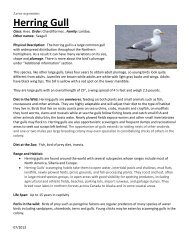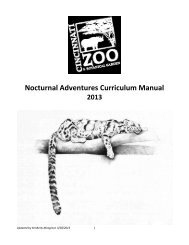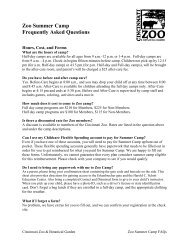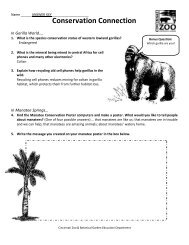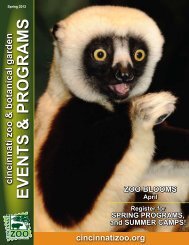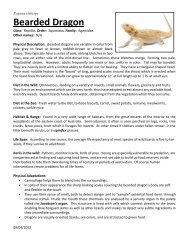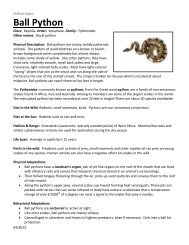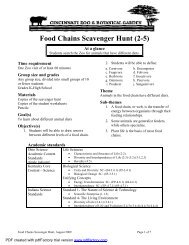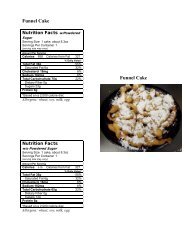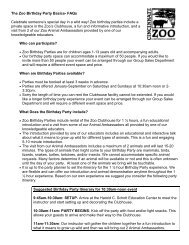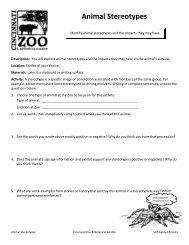2011 CREW ReView - The Cincinnati Zoo & Botanical Garden
2011 CREW ReView - The Cincinnati Zoo & Botanical Garden
2011 CREW ReView - The Cincinnati Zoo & Botanical Garden
- No tags were found...
You also want an ePaper? Increase the reach of your titles
YUMPU automatically turns print PDFs into web optimized ePapers that Google loves.
®Cat Signature Project UpdatesPallas’ Cats from Artificial Insemination –Why it MattersIn June, one of the <strong>Cincinnati</strong> <strong>Zoo</strong>’s Pallas’ cats, Sophia,gave birth to three kittens – the first produced byartificial insemination (AI). While it is always exciting toproduce the first offspring of an exotic species with somenew technique, that accomplishment, in itself, is relativelymeaningless if that first litter turns out to be the onlyone. At <strong>CREW</strong>, our primary goal is not “world’s firsts”,but to develop and apply appropriate scientific tools tohelp conserve endangered wildlife. So we produced theworld’s first Pallas’ cats by AI – why does that matter?Well, first, this AI procedure resulted in the birth of geneticallyvaluable kittens. Sophia and our male, Buster,were paired initially for natural breeding but were not behaviorallycompatible. Most zoo breeding recommendationsare based on pedigree analysis to maximize geneticvariation, but sometimes these prospective mates need alittle help. Second, our success this year with this newtechnique – laparoscopic oviductal (LO) AI – in four catPallas’ cat kittens produced by AIspecies is changing our assisted reproduction strategy for small wild cats. By depositing semen deep into the oviducts, highpregnancy percentages can be obtained using only a few million spermatozoa, especially important with small cat malesthat do not produce large sperm numbers. Third, this AI approach may allow us to use frozen semen more effectively. Inour Pallas’ cat research in Mongolia, we collected, froze and imported semen from ten wild males. Successful AI with thesefrozen samples would create gene flow between isolated populations without transporting any live animals while conservingmore genetic diversity within liquid nitrogen tanks. That helps us to ensure the future survival of Pallas’ cats and THAT iswhy it matters.For our Next Trick - Going LO with Frozen Semenin Cats<strong>The</strong> novel laparoscopic oviductal artificial insemination method (LO-AI), developedin domestic cats by <strong>CREW</strong> scientists, already is helping zoos to propagatetheir imperiled wild cat populations. Just in the past year, we have used this AI approachto produce pregnancies in three exotic cat species, the ocelot, sand cat, andPallas’ cat (see story above). Maintaining a diverse gene pool is crucial to speciessurvival, but finicky felines don’t always breed well naturally and AI provides onepossible remedy. For AI to be most effective for genetic management, incorporationof frozen semen is required, but the freezing process may compromise spermfunction. In a recent study, we assessed the relative fertility of freshly-collected vs.frozen semen for LO-AI. Sixteen domestic cats were inseminated in one oviduct usingfresh spermatozoa (~1 million) from one male and in the opposite oviduct usingtwice the number of frozen-thawed spermatozoa (~2 million) from a second male.DNA samples from the resulting kittens were analyzed by geneticists at the Universityof California to determine paternity. Of the 16 females, half became pregnant,giving birth to 36 kittens. Paternity results proved that eight of these kittens wereconceived with frozen semen, but a higher percentage of kittens (78%, 28/36) wereproduced with fresh sperm suggesting fertility was reduced in the cryopreservedsamples. While promising, these early results indicate alterations in sperm freezingmethods, timing of AI or total sperm numbers may be needed to improve AI successin cats when using frozen semen.Lindner Center for Conservation and Research of Endangered Wildlife • <strong>Cincinnati</strong> <strong>Zoo</strong> & <strong>Botanical</strong> <strong>Garden</strong> 3<strong>2011</strong> <strong>CREW</strong> <strong>ReView</strong>.indd 3 11/22/11 1:59 PM
Plant Signature Project UpdatesNorthern wild monkshoodMonkshoods Spend SummerGetting Stronger<strong>CREW</strong>’s Plant Division has been growing the Northern wild monkshood(Aconitum noveboracense) for several years, developing tissue culturepropagation protocols under an IMLS funded grant, and then working with collaboratorsfrom the Summit Metro Parks in Akron, OH, to produce plants toaugment the small population there. However, after several attempts, none ofthe plants from <strong>CREW</strong> that were planted at the site survived.Each plant species is different in how readily it adapts to the “real world” afterlife in the test tube. In the <strong>CREW</strong> labs, the monkshoods acclimatized readily tolife in soil, but they were not able to survive in the wild, even after months in<strong>CREW</strong>’s greenhouse.In the summer of 2010, in an attempt to make the plants tougher, severalwere planted in the raised beds that Horticulture maintains behind <strong>CREW</strong>. Afterdying back last fall, it was exciting when, this spring, the plants re-appeared,growing bigger and healthier than before. Even more exciting was the productionof flowers. Although no viable seeds have been found yet, the plants formedtubers and demonstrated that they can survive winter. As a result, several plantsfrom the beds have been sent to Akron this fall to see if they survive winter inGorge Metro Park. <strong>CREW</strong> scientists hope the raised beds can serve as a necessarystepping stone, where plants can grow stronger and prepare better for asuccessful life in the wild.A Secure Site for Genetic JewelsAll treasures should be stored in a safe, secure place to guardagainst loss and deterioration. <strong>The</strong> same is true for plants andanimals – the biological treasures of the world. Ideally, they shouldbe guarded within their natural environment, but achieving that goalis challenging for some species because their habitats are being destroyed.Ex situ conservation, or conservation off-site, can providea back-up strategy for endangered plants and animals, and <strong>CREW</strong>’sCryoBioBank is one such “insurance policy.” It also provides a highlyefficient and effective way of maintaining many samples in a small area.<strong>The</strong> Plant Division recently completed a project funded by the Instituteof Museum and Library Services to cryopreserve tissue culturelines of five species representing multiple genetic lines. Maintainingtissues long-term in culture is laborious and associated withrisks like contamination or failure to thrive. Although the freezingprocess requires specialized protocols, over the long-term, it is lessexpensive to cryopreserve tissue lines than to maintain them indefinitelyin culture. As part of this two-year project, <strong>CREW</strong> staff hascryopreserved over 4600 shoot tips of more than 110 genetic lines!<strong>CREW</strong>’s 30th anniversary is witness to our scientists’ longtermcommitment to the survival of the planet’s biodiversity.<strong>The</strong> CryoBioBank serves as a biomaterials resource for the future,and provides an opportunity to build upon the cryopreservationscience base as samples are thawed and tested. With samples Cryopreserved plant specimensfrom over 200 species of some of the rarest plants and animalsin the world, it is definitely a treasure chest of genetic jewels.Lindner Center for Conservation and Research of Endangered Wildlife • <strong>Cincinnati</strong> <strong>Zoo</strong> & <strong>Botanical</strong> <strong>Garden</strong> 5<strong>2011</strong> <strong>CREW</strong> <strong>ReView</strong>.indd 5 11/23/11 5:03 PM
®MILESTONESTHE ERA OF TECHNOLOGY DEVELOPMENT1981-1985<strong>CREW</strong> begins as a founding memberof the <strong>Cincinnati</strong> Wildlife ResearchFederation under the direction ofDr. Betsy Dresser.CryoBioBank is created to storesperm and embryos from endangeredanimals.Antelope embryo transfer in elandand bongo results in many “worldfi rsts.”1986-1990Kittens produced from cryopreserveddomestic cat embryos demonstratethe feasibility of using cryopreservationto help conserve endangeredcats.Dr. Valerie Pence establishes the PlantResearch Division at <strong>CREW</strong> and initiatesthe Endangered Plant PropagationProgram.<strong>CREW</strong>’s fi rst endangered plant species,Trillium, is successfully propagatedin vitro.In vitro fertilization and embryotransfer results in the birth of anIndian desert cat kitten to a domesticcat mother.1991-1995<strong>The</strong> Carl H. Lindner, Jr. Family Centerfor Conservation and Research ofEndangered Wildlife (<strong>CREW</strong>) opensits doors in 1991– the first facility ata zoo dedicated to both animal andplant conservation research.Working with the government ofTrinidad and Tobago, <strong>CREW</strong> spearheadsthe reintroduction of extirpatedblue and gold macaws to theNariva Swamp of Trinidad.“Test-tube” gorilla born after in vitrofertilization and embryo transfer demonstratingthe application of humanreproductive technologies to helppropagate great apes.6<strong>2011</strong> <strong>CREW</strong> <strong>ReView</strong>.indd 6 11/16/11 4:09 PM
®<strong>CREW</strong> <strong>ReView</strong>THE ERA OF MAKING SCIENCE WORK FOR CONSERVATION1996-2000Dr. Terri Roth becomes the newDirector of <strong>CREW</strong> in 1996 and initiatesthe Rhino Conservation Program.2001-2005Strategic planning in 2001 leads to thecreation of “Signature ConservationProjects.”2006-<strong>2011</strong>Ocelots in Brazil and sand cats in theUnited Arab Emirates produced byembryo transfer.<strong>CREW</strong> pioneers “in vitro collecting”technique, and demonstrates its effectivenessin collecting plant tissuesfrom Trinidad, Costa Rica, and severalhabitats in the United States.<strong>CREW</strong> initiates a post-doctoraltraining program to produce futureleaders of conservation research programsworldwide.Dr. Bill Swanson joins <strong>CREW</strong> in 1997as Director of Animal Research andexpands <strong>CREW</strong>’s global small catconservation program to Mongolia,Brazil, Thailand and South Africa.<strong>CREW</strong>’s amphibian research programis initiated with Wyoming and Borealtoads.First endangered cat, an ocelot, bornfollowing the transfer of frozenembryos.Successful 2001 birth of first Sumatranrhino (a male) produced in captivitysince 1889 followed by a secondcalf (a female) in 2004.Successful propagation of <strong>CREW</strong>’s20th rare plant species.Tree embryos shown to be viable after10 years in <strong>CREW</strong>’s CryoBioBank.<strong>CREW</strong> establishes molecular geneticslab and research program.Two term pregnancies produced inthe Indian rhino after artifi cial inseminationwith cryopreserved sperm.First Sumatran rhino calf sent toSumatra and third Sumatran rhino calfborn at the <strong>Cincinnati</strong> <strong>Zoo</strong>.Successful establishment in southernKentucky of an experimental populationof the Cumberland sandwortwith plants propagated through tissueculture at <strong>CREW</strong>.<strong>The</strong> reintroduction of blue and goldmacaws to Trinidad declared a successwith 84% of translocated adultssurviving and producing 48 chicks inthe wild.<strong>CREW</strong> becomes the nation’s headquartersfor monitoring captivepolar bear reproduction.Avon Park harebells successfully outplantedin Florida after tissue culturepropagation at <strong>CREW</strong>.Pollen, spores, and shoot tips in<strong>CREW</strong>’s CryoBioBank prove viableafter 10-15 years in storage.Ocelot and Pallas’ cat kittens producedby new oviductal artifi cialinsemination technique.7<strong>2011</strong> <strong>CREW</strong> <strong>ReView</strong>.indd 7 11/16/11 4:09 PM
®<strong>CREW</strong> Honorary Senior Scientist Leaving LegacyWhen Dr. G. Douglas Winget retired as Professor of BiologicalSciences at the University of <strong>Cincinnati</strong> in 2001and asked if he could join the scientists at <strong>CREW</strong>, nobodycould have predicted the longevity of this Professor Emeritusnor his impact on <strong>CREW</strong>. Trained as a plant biochemist,Doug spent the last decade working on a variety of projects,including the biochemistry of the American chestnut,interspersed with collecting plant tissue in the mountains ofNew Mexico and searching for endangered monkshoods insouthern Ohio --and all as a volunteer. But, perhaps his mostsignificant contribution has been establishing the moleculargenetics program at <strong>CREW</strong>.Doug conducted genetic analyses of numerous genotypesof the endangered species that are being grown and cryopreservedin the Plant Division. One of these, Todsen’s pennyroyal(Hedeoma todsenii), grows on the White Sands MissileBase in New Mexico, and in 2009, Doug obtained a grant Dr. Doug Wingetfrom the U.S. Army for his work documenting the geneticdiversity of that species. He has also assisted scientists in the Animal Division and mentored numerous students and volunteers.“And, he can fix anything!” said one <strong>CREW</strong> scientist. “He saved us hundreds of dollars by discovering that a $5computer chip was causing our autoclave’s dysfunction.”Doug will be phasing into a second “retirement” filled with grandchildren, travelling, hobbies, and friends. We know wewill still see Doug around <strong>CREW</strong>, but we will miss his day-to-day presence. Thank you so much Doug for all your importantcontributions to <strong>CREW</strong> and best wishes from all the <strong>CREW</strong> staff.<strong>CREW</strong> Attracts Area Biotechnology StudentsIn 2008, <strong>CREW</strong> piloted an overnight program for high school teens calledScientists for the Future. This innovative program utilizes <strong>CREW</strong>’s researchlabs, the <strong>Cincinnati</strong> <strong>Zoo</strong>’s animal exhibits and unique animal encountersto provide students an exciting hands-on learning experience. Scientistsfor the Future highlights the conservation challenges facing endangered speciesin the wild and captivity and how <strong>CREW</strong>’s work is helping those species.Participants are encouraged to be better stewards of the environmentby spear-heading their own conservation action projects. Among the mosteager participants are students enrolled in Biotechnology programs throughoutsoutheast Ohio. Over 250 teens representing 8 high schools and careercenters from <strong>Cincinnati</strong> to Bellefontaine Ohio have participated in Scientistsfor the Future. Positive student evaluations indicate participants truly enjoythe unique opportunity to be scientists for a night at <strong>CREW</strong>, and commentsfrom teachers reflect the true value of this program. Among the first to participatein the program, Mr. Marc Cary from Centerville High School stated,“It provided real-world application of scientific concepts, hands-on learningwith guided lab activity and excellent mentorship for students from scientistson the front line of wildlife conservation.” Ms. Rachel, head of SpringfieldHigh School’s Biotechnology class said, “<strong>The</strong> program provided my studentswith first hand information on <strong>CREW</strong>’s research and conservation efforts, affordinga real-world connection to the students’ future endeavors that cannotbe made within a traditional classroom setting.” By integrating science, technology, conservation and community engagement,Scientists for the Future is inspiring the next generation of <strong>CREW</strong> researchers.8Lindner Center for Conservation and Research of Endangered Wildlife • <strong>Cincinnati</strong> <strong>Zoo</strong> & <strong>Botanical</strong> <strong>Garden</strong><strong>2011</strong> <strong>CREW</strong> <strong>ReView</strong>.indd 8 11/23/11 6:45 PM
<strong>CREW</strong> <strong>ReView</strong>Rhinos Drool for <strong>CREW</strong>Melissa Nau, a <strong>2011</strong> P&G Wildlife Conservation Scholar,joined <strong>CREW</strong> scientist Dr. Monica Stoops andOSU Professor, Dr. Carlos Pinto this past summer to investigatethe relationship between salivary and urinary hormonesthroughout the Indian rhino estrous cycle. To date, urinaryhormone analysis has been used to time natural breeding andartificial insemination (AI) in the Indian rhino. However,collecting clean urine samples consistently can be a challengeand has limited the number of rhinos available for urinaryhormone monitoring. Reproductive hormones can alsobe detected in saliva, and have previously been measured ina female Indian rhino. However, before saliva can be usedas the sole biological sample to monitor reproductive activityin this species, it must be proven reliable and reflectiveof urinary hormone profiles. In <strong>CREW</strong>’s endocrinology lab,Melissa conducted enzyme immunoassays to measure hormoneconcentrations in matched saliva and urine samples Melissa Nau collecting rhino salivacollected from female Indian rhinos. Melissa’s research confirmed that salivary hormones do provide similar time-pointpredictors of ovarian function in the Indian rhino <strong>The</strong>se results, in turn, may benefit the numbers of individual Indian rhinosand institutions that can participate in endocrine analysis to time natural breeding or AI procedures. Now, that is somethingIndian rhinos can drool about!Something’s Fishy - P&G Scholar ExploresBladder Cancer in the Fishing CatEmily Marshall with Minnowthe fishing cat.Emily Marshall, a P&G Wildlife Conservation Scholar and first year OSU veterinary student,devoted her summer vacation to exploring an unusual disease, bladder cancer, in an unusualspecies, the fishing cat (Prionailurus viverrinus). In this study, Emily was mentored by Drs.Tony Buffington of OSU and Bill Swanson of <strong>CREW</strong> as she investigated the overall prevalenceand potential causes of bladder cancer in fishing cats in North American and international zoos.Emily also worked with Russ Kelley, Senior Scientist for P&G Pet Care, to conduct dietary andbiological sample analysis to identify nutritional factors, such as lack of fish in diets, possiblyaffecting cancer occurrence. Emily documented 28 bladder cancer cases over the past 15 yearsin North American zoos plus additional cases in Europe and Australia, establishing this diseaseas a global concern. Although fish typically comprises less than 20% of zoo diets for fishingcats, a direct relationship to bladder cancer has not yet been shown. Nutritional analysis of dietsand blood samples are ongoing and follow-up dietary studies are planned for 2012. As for Emily,she has decided to continue her fishing cat studies in a joint MS/DVM degree program atOSU with future aspirations of becoming a veterinary nutritionist.P&G Wildlife Conservation Scholarship Program forVeterinary Students at <strong>CREW</strong>Anew summer scholarship program has been established with the support of Procter & Gamble Pet Care to givehands-on scientific training to veterinary students interested in pursuing wildlife conservation research as a possiblecareer focus. In a partnership between <strong>CREW</strong> and the Ohio State University’s College of Veterinary Medicine,the P&G scholarship will provide salary, research and travel support to two veterinary students each year to conductwildlife research studies with mentoring by OSU and <strong>CREW</strong> scientists.Lindner Center for Conservation and Research of Endangered Wildlife • <strong>Cincinnati</strong> <strong>Zoo</strong> & <strong>Botanical</strong> <strong>Garden</strong> 9<strong>2011</strong> <strong>CREW</strong> <strong>ReView</strong>.indd 9 11/23/11 5:43 PM
<strong>CREW</strong> Scientific HighlightsPEER-REVIEWED PUBLICATIONSStoops MA, JK O’Brien and TL Roth. <strong>2011</strong>.Gamete rescue in the African black rhinoceros(Diceros bicornis). <strong>The</strong>riogenology 76:1258-1265.Plair BL, PR Reinhart and TL Roth. <strong>2011</strong>.Neonatal milestones, behavior and growth rateof Sumatran rhinoceros (Dicerorhinus sumatrensis)calves born and bred in captivity. <strong>Zoo</strong>Biology 30:1-15.Pence VC. <strong>2011</strong>. <strong>The</strong> possibilities and challengesof in vitro methods for conservation.Kew Bulletin 65: 539-547.Pence VC. <strong>2011</strong>. Evaluating costs for in vitropropagation and preservation of endangeredplants. In Vitro Cellular and DevelopmentalBiology -- Plant 47:176-187.Reed, BM, V Sarasan, M Kane, E Bunn andVC Pence. <strong>2011</strong>. Biodiversity conservationand conservation biotechnology tools. In VitroCellular and Developmental Biology -- Plant47:1-4.Stoops MA, HL Bateman, MK Campbell andTL Roth. <strong>2011</strong>. Attempted in vitro maturationand fertilization of postmortem Sumatranrhinoceros (Dicerorhinus sumatrensis) oocytes.Journal of <strong>Zoo</strong> and Wildlife Medicine42(4):723-726.SCIENTIFIC PRESENTATIONSStoops MA. <strong>2011</strong>. Artifi cial insemination inthe greater one-horned rhinoceros (Rhinocerosunicornis). Proceedings of the 7th InternationalRhino Keeper Workshop. InvitedKeynote Speaker, Glen Rose, TX.Nau M, C Pinto, R Pairan, R Sims and MAStoops. <strong>2011</strong>. Relationship of salivary hormoneconcentrations to urinary hormone excretionprofi les in the Indian rhinoceros (Rhinocerosunicornis). Ohio State UniversityStudying SalamandersCollege of Veterinary Medicine Summer ResearchProgram Book of Abstracts (abstract27). Poster presentation, Columbus, OH.Stoops MA, ST Ferrell, GD West, TL Roth andNP Lung. 2010. Use of urinary biomarkers ofovarian function to enhance captive breedingsuccess in the Indian rhinoceros (Rhinocerosunicornis). Proceedings of the InternationalSociety of Wildlife Endocrinologists. Oral presentation,<strong>Cincinnati</strong>, OH.Bateman HL, K Pelican and WF Swanson.<strong>2011</strong>. Assessing the effi cacy of a GnRH agonistimplant (Deslorelin) to reduce reproductiveand stress hormone levels and behavioral aggressionin single-sex groups of captive Asiansmall-clawed otters. Hystrix, Italian Journal ofMammalogy Suppl. p. 88. Oral presentation,Pavia, Italy.Bateman HL and WF Swanson. <strong>2011</strong>. Use ofnon-invasive fecal hormonal analysis to determinegender in North American river and Asiansmall-clawed otters. Hystrix, Italian Journal ofMammalogy Suppl. p. 52. Poster presentation,Pavia, Italy.Conforti VA, HL Bateman, MM Vick, J Newsom,LA Lyons, RA Grahn, JA Deddens andWF Swanson. <strong>2011</strong>. Improved fertilizationsuccess using laparoscopic oviductal artifi cialinsemination with low sperm numbers in domesticcats. Proceedings of the Society forthe Study of Reproduction p. 40 (abstract 173).Oral presentation, Portland, OR.Marshall E, W Swanson, R Kelley, T Vennardand T Buffi ngton. <strong>2011</strong>. Investigation of epidemiologicaland nutritional factors associatedwith the high prevalence of transitional cell carcinomain fi shing cats (Prionailurus viverrinus).Ohio State University College of VeterinaryMedicine Summer Research Program Book ofAbstracts (abstract 23). Poster presentation,Columbus, OH.Vick MM, HL Bateman and WF Swanson.<strong>2011</strong>. Improved cryopreservation of domesticcat spermatozoa in a soy lecithin-based extender.Proceedings of the International EmbryoTransfer Society. Reproduction, Fertilityand Development 23:153-154. Poster presentation,Orlando, FL.Swanson WF, B Oyuntuya, M Brown, M Gilbert,A Fine, S Ross, K Volle, J Van Milligen,T-O Bira and B Munkhtsog. 2010. Is toxoplasmosisa potential emerging disease for wildlife,domestic animals and humans in Mongolia?Proceedings of the Annual Meeting of theAmerican Association of <strong>Zoo</strong> Veterinarians pp.20-21. Oral presentation, Padre Island, TX.Roth TL, KM MacKinnon and MA Stoops.<strong>2011</strong>. Non-invasive fecal hormone monitoringfor evaluating polar bear (Ursus maritimus) reproductiveactivity. Proceedings of the InternationalBear Association’s International Conferencefor Bear Research and Management p.69. Oral presentation, Ottawa, Canada.Pence VC. <strong>2011</strong>. In vitro propagation and cryopreservationfor the conservation of endangeredspecies of Saintpaulia. In Vitro Cellularand Developmental Biology 47:S59. (AbstractP-2024). Interactive poster presentation, Societyfor In Vitro Biology, Raleigh, NC.Pence VC. <strong>2011</strong>. In vitro methods and thechallenge of exceptional species for Target 8of the GSPC. A Global Partnership for PlantConservation--Supporting the Worldwide Implementationof the GSPC. Invited oral presentation,St. Louis, MO.STAFF AWARDSDr. Valerie Pence - Fellow Award, Society forIn Vitro Biology, Raleigh, NC.Dr. Terri Roth – Association of <strong>Zoo</strong>s andAquariums Outstanding Service Award, Atlanta,GA<strong>The</strong> Black Warrior waterdog is considered one of the most endangered salamandersin the continental United States due its pronounced reproductive seasonality andnarrow geographic range. This rare species is limited to the Black Warrior River basinof Alabama in habitat fragmented and degraded by human development. Recent surveysconducted by <strong>CREW</strong> scientists and the zoo’s amphibian staff indicate that the situationmay be more dire than previously thought. While conducting the in situ surveys,a small DNA sample is obtained from captured waterdogs prior to their release. Thismaterial provides the foundation for genetic studies <strong>CREW</strong> has initiated in collaborationwith scientists at the <strong>Cincinnati</strong> Museum Center to help delineate the current levelof genetic variability in the last known population of Black Warrior waterdogs. Early findings suggest that the gene flowamong Black Warrior waterdog populations has been reduced. Further studies are underway to determine the evolutionaryrelatedness of all waterdogs found throughout Alabama and in other Southeastern states. Waterdogs have also been sampledfor the presence of chytrid, an invasive fungus killing amphibians around the world, and to evaluate the condition and healthof each animal. <strong>CREW</strong>’s work is contributing to the database necessary for both assessing the overall health of the BlackWarrior River basin and identifying next steps for reducing extinction risks to this unique salamander.10Lindner Center for Conservation and Research of Endangered Wildlife • <strong>Cincinnati</strong> <strong>Zoo</strong> & <strong>Botanical</strong> <strong>Garden</strong><strong>2011</strong> <strong>CREW</strong> <strong>ReView</strong>.indd 10 11/16/11 4:10 PM
<strong>CREW</strong> <strong>ReView</strong>Friends of <strong>CREW</strong>Our sincere gratitude to the following who gave $100 or more in 2010:$10,000+ donorsBanfi VintnersMs. Iris de la MotteDepartment of the ArmyEQ Cooking School at theParty SourceMrs. Elizabeth HoffmanInstitute of Museum andLibrary ServicesKeyBankSamuel AdamsShumaker Family FoundationWeldco/Buildco IncorporatedMrs. Mae Snow WoodYoung Family Foundation$5,000 - $9,999William P. Anderson FoundationAnonymous Fund of the Greater<strong>Cincinnati</strong> FoundationArchbold Biological StationDr. and Mrs. Thomas E. BellAZA/Conservation Endowment FundLucile and Richard Durrell SpecialFund II of the Greater<strong>Cincinnati</strong> FoundationMr. and Mrs. Roger W. Gross<strong>The</strong> David J. Joseph Company$2,500 - $4,999Dallas W. and Helen B. BowyerCharitable TrustMr. Robert A. JohnstonJ. David & Kathleen A. RobertsFamily Foundation$1,000 - $2,499Allyn’s CaféAllan and Anita BeachMr. and Mrs. Robert A. BechtelBella LunaBexley City School DistrictMrs. Eliza L. BiedermanTim and Kelly BrownBruegger’s Bagel BakeryBuffalo Wild WingsCentral Indiana Cage-Bird Club, Inc.City BBQMrs. Mary Ann M. DodsonCharles M. Dolgas andKaren M. AbellFairchild Tropical Botanic <strong>Garden</strong>Carolyn and Ralph FriedmanMr. and Mrs. John F. Gabriel, Jr.Shirley GallagherSharon and Robert Gill Family Fundof the Greater <strong>Cincinnati</strong> Founda -tionMark P. Herschede Fund of <strong>The</strong>Greater <strong>Cincinnati</strong> FoundationMr. and Mrs. Jeremy S. HiltonMr. and Mrs. William J. JanowiczMr. James JennyJohn MorrellKeystone Bar and GrillBob and Judy LichtMr. Roger H. LindemannLittle Ceasar’s PizzaMadisono’sDr. and Mrs. Robert L. McLaurinMary Ann MeanwellMorris Animal FoundationNeuberger Berman LLCMr. Charles E. NoeNoodles and Co.Steve and Margie Nordlund-ConawayPenn StationMr. and Mrs. Robert PikeRemke/Bigg’sGlenn and Lana RogersDr. Terri L. Roth andDr. William F. SwansonS2 Statistical Solutions, Inc.Mr. Gus Schmidt &Miss. Peggy SchmidtPaul and Jeanne SchneiderSeñor Roy’s Taco TruckSmarter Learning SystemsSmoky Bones Bar and Fire GrillMorgan Stanley FoundationKen and Carol StecherTom and Dee StegmanMr. and Mrs. Gary L. StoopsTano CateringTaste of BelgiumDr. and Mrs. David E. TaylorTaz Mediterranean and LebaneseMr. and Mrs. Kenneth TomposWhole Foods MarketDebra WilliamsonYagöötZZ’s Pizza$500 - $999Tom and Bev BardenMrs. Robert M. BergsteinMr. and Mrs. Elroy E. BourgrafMs. Eugenie BradfordMrs. Stephen S. Bullock andMs. Laurie BuckDonna and Pat CarruthersMiss Kathy ConlonMr. and Mrs. Joseph W. CushallDaniel Boone National ForestMs. Mary Elizabeth DodsonNita and Andy DouglasMrs. John C. DupreeDennis and Allison Gibbs<strong>CREW</strong> Wish ListMicrocentrifugeRequired for the isolation of plant DNA,the microcentrifuge is used every day.Age and near constant-use have takenits toll, and the microcentrifuge is beyondrepair. Cost: $2690Mr. and Mrs. Joseph N. GreenHamilton Community FoundationHugh H. HoffmanMr. and Mrs. John HowieMr. and Mrs. Carl F. KalnowDr. and Mrs. Scott A. KleinerMr. and Mrs. Stephen M. KralovicDr. and Mrs. Steven R. MooreDoreen QuinnRed Stone Farm, LLCMr. and Mrs. Jack RolfMs. Jodi L. Sampson andMr. Martin WalshMr. Eli E. Shupe, Jr. andMs. Toby RubenMs. Arlene A. Thorwarth$100 - $499Mr. Anatole Alper andMs. Audrey AlbinMs. Susan AndersonMr. Boris AstafievW. Terry Averbeck and<strong>The</strong>resa T. AverbeckMr. Kenneth A. AyerMr. and Mrs. Peter G. AyersMr. and Mrs. Carl BamfordMr. Robert BarbellaBarron Peck Bernie &Schlemmer Co. LPALois G. BenjaminMr. and Mrs. William C. BeuttelMs. Mary A. BinderMs. Helen BlackJoanna BoutilierMs. Bridget BrannonMr. Marion T. BrantMrs. Dorothy BroadfootMs. Jeannie S. BrowneGary and Angie ButterbaughDr. Mark K. CampbellRob and Heather CarlisleMr. Andrew ChrienMr. Paul W. Christensen, Jr.<strong>Cincinnati</strong> USA Convention &Visitors Bureau<strong>Cincinnati</strong> Wellesley Club<strong>The</strong> <strong>Cincinnati</strong> Wild FlowerPreservation SocietyMr. Edward J. ClarentonMr. Peter R. Coombe and Ms.Betty ChenWilfred A. and Judith S. CoteMr. and Mrs. Herbert W. CoulterChris & Janice CubbisonMr. and Mrs. John J. CurleyMs. Michelle D. CurleyMs. Clara DanticDr. Dan DavisData LoggerData loggers are needed to record the temperatureand humidity in the microenvironmentswhere plants grow so that <strong>CREW</strong> scientistscan better mimic natural conditionsin the lab. Cost: $300 each. (Need up tofour.)Dr. and Mrs. Rank O. Dawson, Jr.Guy and Cathy DeDiemarMr. Robert C. DehnerMr. and Mrs. James K.Dempsey IIIDr. and Mrs. Donald A. DietrichMr. and Mrs. Jerome H. EichertDr. Nancy H. EisenbergMr. Ryan ErbErie <strong>Zoo</strong>logical SocietyMrs. <strong>The</strong>resa Deters GerrardGoldman, Sachs & Co.Mr. and Mrs. Steven P. GoodinMs. Mona GossGrants Etcetera, Inc.<strong>The</strong> William H. & Grace H. HagenbuchFund of the DaytonFoundationMr. and Mrs. Stewart F. HallRichard J. HardestyMr. and Mrs. Michael Harness<strong>The</strong> Heart of Jacksonville AfricanViolet SocietyMr. W. August HillenbrandMrs. Florence HoffmannMr. and Mrs. Steven A. HoffmannMr. and Mrs. Daniel L. HoldenMs. Karen S. HoltzappleMr. Stanley A. Hooker IIIMs. Cristina HugMs. Joanne Jeffrey andMr. Steve CostaMr. Donnie R. JohnsonMr. and Mrs. Michael D. JonesMr. Todd Jones andMs. Najwa TurpenMs. Annamarie KahlerMrs. Karen Kamfjord<strong>The</strong> KETT Tool CompanyMr. and Mrs. Jeff Kraft, Dr. andMrs. Gilbert EzellMr. and Mrs. Thomas LindstromDr. Jennifer M. LoggieMr. Camden D. McClungMr. and Mrs. John D. Menke, Sr.Drs. F.W. Manfred andSusan M. MenkingMr. Greg MerkleMs. Kathleen MerrickMetheney Charitable Gift FundMs. Kathy MeutiMr. and Mrs. Franklin D. MikelMr. and Mrs. Stanley R. MillerMs. Cynde NovawaMs. Marilyn Z. OttMr. Michael A. Paul andMs. Cathy ClabornMr. Andrew J. PelehosDr. and Mrs. Paul H. PerlsteinMr. and Mrs. Leland S. Person, Jr.Mr. and Mrs. Kevin PlairRaithel Family Fund of the FidelityCharitable Gift FundMr. Anil RalhanIrene and Daniel Randolph FamilyMr. and Mrs. Robert D. ReceMr. and Mrs. David F. ReidMs. Janet K. RinehartMr. Edward RobertsMs. Laura V. RobertsonMr. Noel B. RoweMr. and Mrs. Thomas A. RuddMr. and Mrs. Douglas K. RyanMr. and Mrs. Robert D. ScallanStuart and Roselyn SchlossDr. Janis E. Schmidt andMr. David PariseauMrs. Jean SchmidtMr. and Mrs. Frederick R. SchneiderMrs. Martha S. SeamanMr. and Mrs. Hugh ShipleyStanley and Beverly ShoresDr. and Mrs. Siegfried E. SieberMr. and Mrs. Murray Sinclaire, Jr.Mr. and Mrs. Robert E. Singer, Jr.E. Gregory SmithMr. and Mrs. Steven C. SmithCharles and Carol SpecterMr. and Mrs. Christopher L. SprenkleDr. Donna L. StahlMr. Timothy E. StaigerMs. Martha A. StimsonMr. and Mrs. Patrick R. StoryMr. and Mrs. Charles M. StrebelDiana and Frank SzecskayMs. Linda A. TacheMs. Julie M. TemperleyMr. and Mrs. Edward W. TerrillMs. Judy A. TesselJames L. ThompsonMr. Steven TorbeckMr. Leo T TsaiUS Environmental Protection AgencyMs. Madge Van BuskirkMs. Diane R. Vogelsang andMs. Roxanne MosesMs. Lisa Vollmer and Ms. Cassie VollmerMrs. Karen B. WachsMiss Katrina L. WahlMr. Richard E. WaltherMr. Harvey M. WeitkampMr. and Mrs. Reid WellsCynthia C. Wetzel, PhDDrs. Jeffrey T. and Kyra R. WhitmerMrs. Nancy P. WickemeyerWood, Herron & EvansMs. Mary K. WoolfordWright State UniversityMs. Judy R. WrightFreezer Storage RacksOur ultra-cold freezer needs storage racksto organize the thousands of invaluable biologicalsamples collected from wildlife overthe years. Cost: $200 each. (Need six)Pulse Oximeter - for monitoring heart rateand blood oxygen saturation during surgery.Cost: $800.Lindner Center for Conservation and Research of Endangered Wildlife • <strong>Cincinnati</strong> <strong>Zoo</strong> & <strong>Botanical</strong> <strong>Garden</strong> 11<strong>2011</strong> <strong>CREW</strong> <strong>ReView</strong>.indd 11 11/23/11 6:10 PM
<strong>Cincinnati</strong> <strong>Zoo</strong> & <strong>Botanical</strong> <strong>Garden</strong>Center for Conservation and Research of Endangered Wildlife3400 Vine Street<strong>Cincinnati</strong>, Ohio 45220-1399 USANON PROFITORGANIZATIONU.S. POSTAGE PAIDCINCINNATI, OHIOPERMIT #1505From Passionate Employee to Invaluable Volunteer –Bernadette Plair Retires from <strong>CREW</strong>Rare are the moments in life when one has an opportunity to help change the world. Throughout her career, BernadettePlair has been a pillar to <strong>CREW</strong>’s mission of Saving Species with Science. Not only has she seized a myriad of opportunities,but she patiently served and guided others to accomplish their professional and personal goals. Whether workingon assisted reproductive techniques in animals and plants, developing cryopreservation protocols for endangered plants,reintroducing Blue and gold macaws to Trinidad, mentoring co-op students or guiding ZVOs in the first Sumatran rhino cowcalf behavior study, Bernadette embraced the diversity of her learning and teaching opportunities with undaunted passion.Along with facilitating several local, national and international workshops, she instructed Earth Expeditions coursesin Trinidad, Belize and Namibia and supported the <strong>Zoo</strong>’sWild Research program and <strong>Zoo</strong> Expeditions in partnershipwith Miami University’s Project Dragonfly. She pioneered<strong>CREW</strong>’s Scientists for the Future Overnight Program andpartnered with Polar Bears International to raise teen andcommunity awareness of climate change. “I see hope forthe future cradled in the arms of the next generation. I wantthem to understand how important it is for them to take upthis challenge”. Bernadette’s greatest inspiration remains herfamily. Fueled by the encouragement of her husband andthree children, she continued to pursue her dreams. Nowshe wants to devote more time to her three granddaughtersand will retire at the end of <strong>2011</strong>. Her deep love and gratitudegoes to all who have made her 20+ years at the <strong>Cincinnati</strong><strong>Zoo</strong> & <strong>Botanical</strong> <strong>Garden</strong> so memorable and rewarding.Bernadette Plair<strong>2011</strong> <strong>CREW</strong> <strong>ReView</strong>.indd 12 11/28/11 12:46 PM



